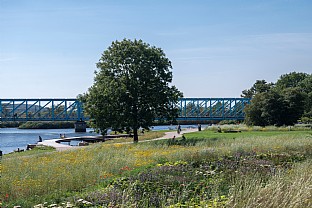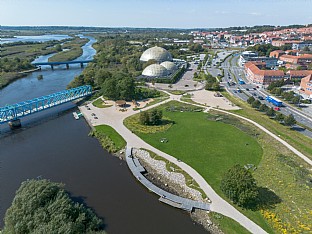The green space, with views over the Gudenå River, is a popular spot for picnics, school classes, physical activities, canoe trips, and events. With the climate adaptation measures at Justesens Plæne, the area has been preserved as a green natural space with room for communities and recreational activities. The establishment of a new green dyke protects the town of Randers from flooding by the Gudenå, Denmark’s most famous and longest river. At the same time, the dyke forms a barrier against an adjacent busy road and brings tranquillity to the area.
The dyke is linked to a broader project called “Klimabåndet” (Climate Ribbon) by the Gudenå River, forming a cohesive flood protection system throughout Randers town centre. A pumping station is designated to be directly integrated into the dyke later, to ensure that water from the urban catchment area can continue to be discharged into the Gudenå river even if water levels are high.
Urban nature area with climate adaptation and biodiversity
The Justesens Plæne area is part of the “River City Randers” development plan, which C.F. Møller is also behind, adapting Randers for future climate challenges and creating attractive places to stay in recreational surroundings.
The design includes a stone embankment along the riverbank so that the tidal flow can be experienced up close, and a curved bridge offers the possibility of sitting by the water. In addition to spaces for play and events, areas are reserved for relaxation, with strategically placed beds where native species of grasses, flowering herbs, and perennials increase biodiversity. Furthermore, Justesens Plæne offers a picnic house, recreational areas rich in nature, a toilet building, and a playground and movement area made of natural materials.
The planting is characterized above all by the proximity to the stream and fjord, and the slightly salty water that can occasionally flood the area. Thus, the development of Justesens Plæne ensures a green oasis focused on nature and biodiversity, enriching the town's life while strengthening its resilience against nature’s forces.
The area is an important public space for recreational use, and the development has involved extensive involvement of the local users as part of the River City Randers project.






